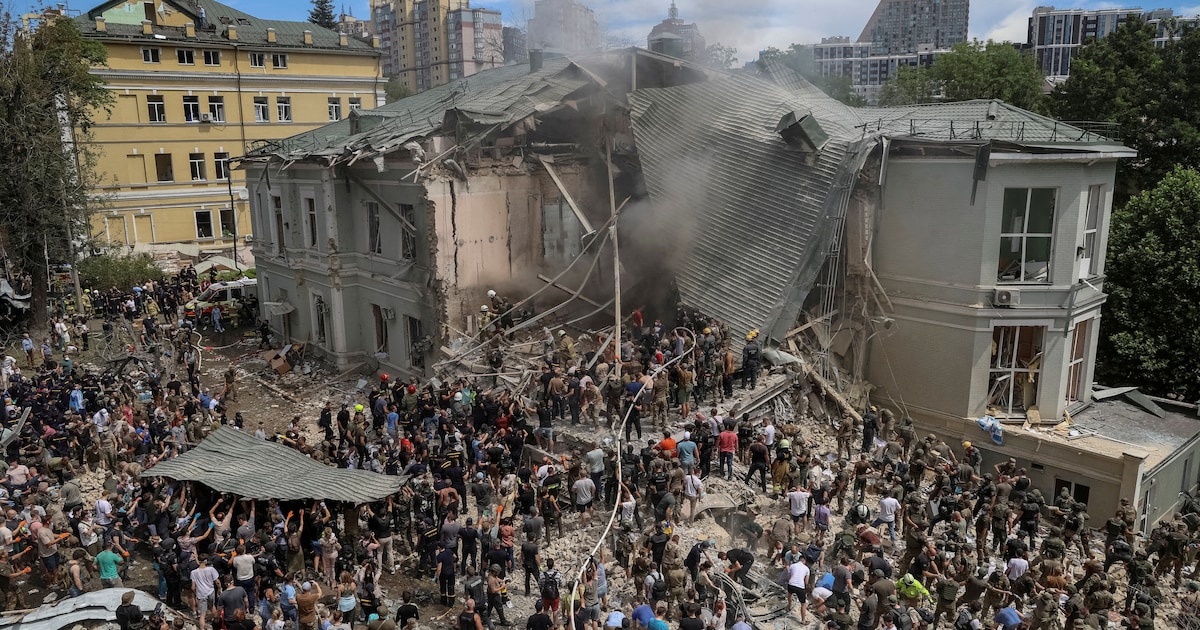
Last Monday it became clear once again how urgent Ukraine’s need for air defence is. Russian cruise missiles hit a children’s hospital in kyiv, causing forty deaths. As if Russia, on the eve of the NATO summit in Washington, wanted to stress once again that it will stop at nothing to win the war: not only power plants and residential areas are targets to demoralise Ukrainians, but also a children’s hospital with cancer patients.
“Yes, this happened on purpose,” says Patrick Bolder, a defence specialist at the Centre for Strategic Studies in The Hague (HCSS). He concludes this from the images of the missile’s impact and how the Ukrainian air defence was, as before, “saturated” with attacks from various types of missiles and drones. “The Russians are learning where the weaknesses of Ukraine’s air defences are and what they can do to exploit them and get their missiles where they want.”
‘Historical’
US President Biden on Tuesday evening promised a “historic donation of defence systems” to Ukraine. The United States and other countries, including the Netherlands, will supply five additional air defence systems, he promised. These are primarily the Patriots and the comparable Franco-Italian Samp-T – advanced installations that shoot enemy aircraft and missiles out of the sky with missiles.
It is difficult to say how many of these Ukraine currently has. With the systems now promised, there will be more than ten, Bolder believes. “But such a system consists of many elements: a radar, a command post, communication vehicles, up to five firing installations per system and, of course, the missiles themselves. That makes it difficult to say what a Patriot system is.”
Shortage
It is equally difficult to determine exactly how much Ukraine needs. You cannot say: one installation covers so many square kilometres and then divide it by the area of Ukraine, Bolder explains. “This system looks in a specific direction, with a field of view about 50 kilometres wide. If you want to cover Ukraine’s 2,500-kilometre border with Russia and Belarus, you need fifty systems. Many of them are not available anywhere in the world and Ukraine cannot organise so many trained teams.”
Anti-aircraft missiles for Patriot systems are also in short supply and expensive. American-made rockets cost between €1 million and more than €3 million each, depending on the type. The manufacturing industry is lagging behind Ukraine’s pace. Plans by the Netherlands, Romania and Germany to produce them under license will not bear fruit for another year or two, Bolder believes. “Often you have to fire two anti-missiles at one incoming missile. If you get forty threats two or three times a week, you fire eighty missiles every week. That makes it even more expensive, and supplies run out very quickly.”
The Patriots are ideally suited to shoot down aircraft or missiles that fly more than 10 kilometers and move quickly, such as Russian ballistic and cruise missiles. Russia’s hypersonic missiles, which travel faster than the speed of sound, have also been difficult for Ukrainian air defenses to shoot down, but they have not proven as invulnerable as Moscow claimed. But on Monday, Ukrainian defenses were powerless against the low-flying, zig-zagging cruise missiles.
Difficult decisions
Shortages and Russian cruelty are forcing Ukraine to choose which targets it wants to protect. The government center or a hospital? Frontline troops or the port of Odessa? A power station or an airbase? Or should Ukraine use them against Russian fighters shelling Ukrainian positions and villages from behind the border?
Ukraine also needs to choose which defenses to use against which threats. No expensive Patriots are used against the drones that cost a few thousand euros and are used by Russia. In addition to old Russian-made supplies and new home-grown products, Ukraine has received a large number of Western repellents: Iris-T, Samp-T, Gepard-PRTL, Stinger, Hawk and Nasams.
Yes, Bolder agrees, such a mix of systems, operated by personnel who must be trained separately, poses an organisational problem for Ukraine. “These systems can operate separately, but they are not very effective. In reality, they have to be integrated into a network where, for example, radar information is exchanged about which missiles are coming and central decisions are made about who does what and what is let go.” But even in the Netherlands, which has fewer different systems, we have not yet managed to integrate them all into a single system.
Bolder sees no signs that Russia is running out of supplies or can no longer produce new missiles because of sanctions. “They have received missiles from North Korea, Iran is helping them and China is also continuing to export.”dual use‘Technological products that can be used. There are leakage currents everywhere, so no, this does not seem to be ending yet.’
Read also:
Russia destroys children’s hospital in massive rocket attack in Ukraine
In the “worst attack since the outbreak of war”, a children’s hospital was attacked in kyiv.

.jpg?w=150&resize=150,150&ssl=1)



